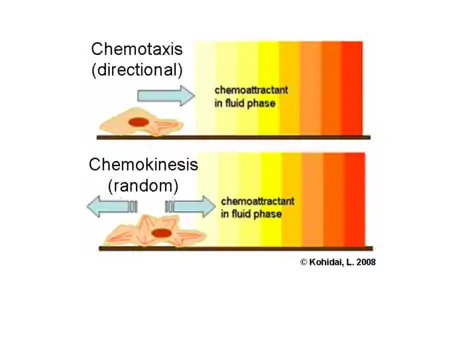Chemokinesis
Chemokinesis is chemically prompted kinesis, a motile response of unicellular prokaryotic or eukaryotic organisms to chemicals that cause the cell to make some kind of change in their migratory/swimming behaviour. Changes involve an increase or decrease of speed, alterations of amplitude or frequency of motile character, or direction of migration. However, in contrast to chemotaxis, chemokinesis has a random, non-vectorial moiety, in general.[1]
[2]
Due to the random character, techniques dedicated to evaluate chemokinesis are partly different from methods used in chemotaxis research. One of the most valuable ways to measure chemokinesis is computer-assisted (see, e.g., Image J) checker-board analysis, which provides data about migration of identical cells, whereas, in Protozoa (e.g., Tetrahymena), techniques based on measurement of opalescence were also developed.[3]

References
- Becker EL (1977). "Stimulated neutrophil locomotion: chemokinesis and chemotaxis". Arch Pathol Lab Med. 101 (10): 509–13. PMID 199132.
- Wilkinson PC. (1990). "How do leucocytes perceive chemical gradients?". FEMS Microbiol. Immunol. 2 (5–6): 303–11. doi:10.1111/j.1574-6968.1990.tb03533.x.
- Leick V, Hellung-Larsen P. (1992). "Chemosensory behaviour of Tetrahymena". BioEssays. 14 (1): 61–6. doi:10.1002/bies.950140113. PMID 1546982.
